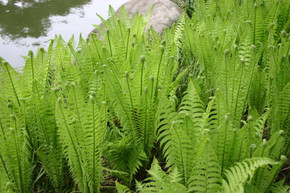
Dryopteris goldiana - GOLDIE'S WOOD FERN
The biggest of North American Dryopteris species. Slowly spreads wide.
For shade garden with average to moist soils.
Blooming Time: not flowering
Size: 3-4' tall x 4-6' wide, in time forms wider colonies
USDA Zones: 3 to 7
Culture: full to partial shade, soils with organic material or organic mulch (leaf debris), medium moist to moist, neutral or acidic
Moisture Needs: average to wet. Adaptable, but likes moisture
Origin: native to bigger part of eastern USA and Canada (except deep south) - see BONAP distribution map. Naturally grows in old deciduous forests, ravines, along streams, swamps and seep edges.
Black Walnut Tolerant: yes
Deer/Rabbit Resistant: yes / yes
Attracts Butterflies or Pollinators: no / no
Attracts Hummingbirds: no
Pot Size: square 3.5" x 4" deep perennial pot
Plant Combinations: Can be combined with any half shade or shade tolerant plant - Actaea (Cimicifuga), Alchemilla, Anemone japonica, Bergenia, Brunnera, Dicentra, Digitalis, Epimedium, hardy Geranium, Hosta, Primula, Polygonatum, Salvia koyame. Looks wonderful with more fine structures of grasses like Carex (both narrow and wide- leaved), Deschamspia, or Hakonechloa.
Good with spring ephemerals and bigger bulbs (Narcissus).
Picture copyright : Hayes Jackson

Dryopteris goldiana - GOLDIE'S WOOD FERN
The biggest of North American Dryopteris species. Slowly spreads wide.
For shade garden with average to moist soils.
Blooming Time: not flowering
Size: 3-4' tall x 4-6' wide, in time forms wider colonies
USDA Zones: 3 to 7
Culture: full to partial shade, soils with organic material or organic mulch (leaf debris), medium moist to moist, neutral or acidic
Moisture Needs: average to wet. Adaptable, but likes moisture
Origin: native to bigger part of eastern USA and Canada (except deep south) - see BONAP distribution map. Naturally grows in old deciduous forests, ravines, along streams, swamps and seep edges.
Black Walnut Tolerant: yes
Deer/Rabbit Resistant: yes / yes
Attracts Butterflies or Pollinators: no / no
Attracts Hummingbirds: no
Pot Size: square 3.5" x 4" deep perennial pot
Plant Combinations: Can be combined with any half shade or shade tolerant plant - Actaea (Cimicifuga), Alchemilla, Anemone japonica, Bergenia, Brunnera, Dicentra, Digitalis, Epimedium, hardy Geranium, Hosta, Primula, Polygonatum, Salvia koyame. Looks wonderful with more fine structures of grasses like Carex (both narrow and wide- leaved), Deschamspia, or Hakonechloa.
Good with spring ephemerals and bigger bulbs (Narcissus).
Picture copyright : Hayes Jackson



